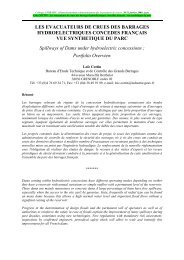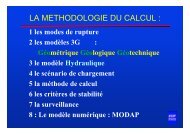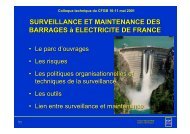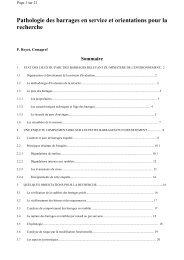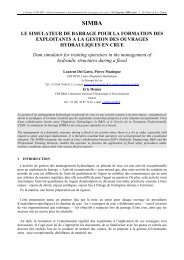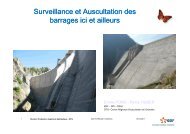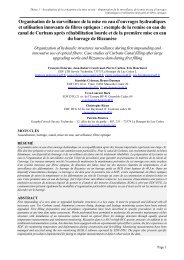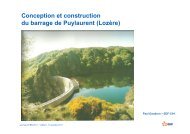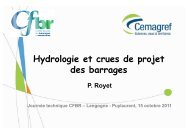SMALL DAMS
SMALL DAMS - CFBR
SMALL DAMS - CFBR
- No tags were found...
Create successful ePaper yourself
Turn your PDF publications into a flip-book with our unique Google optimized e-Paper software.
FRENCH COMMITTEE ON LARGE <strong>DAMS</strong><br />
COMITÉ FRANÇAIS DES GRANDS BARRAGES<br />
<strong>SMALL</strong> <strong>DAMS</strong><br />
Guidelines for Design,<br />
Construction and Monitoring<br />
Coordination : Gérard Degoutte
FRENCH COMMITTEE ON LARGE <strong>DAMS</strong><br />
COMITÉ FRANÇAIS DES GRANDS BARRAGES<br />
<strong>SMALL</strong> <strong>DAMS</strong><br />
Guidelines for Design, Construction<br />
and Monitoring<br />
Coordination : Gérard DEGOUTTE (ENGREF)<br />
Réalisé avec la participation financière du ministère<br />
de l'Agriculture et de la Pêche<br />
Direction de l'Espace Rural et de la Forêt<br />
- France -
PHOTOGRAPH REFERENCES<br />
Cover: CACG, l'Arrêt-Darré dam (Hautes-Pyrénées, France)<br />
Ph. 19 : C.A.C.G.<br />
Ph. 15 – 18 : CARA<br />
Ph. 1, 2, 4, 7, 9 – 10 : E. Alonso<br />
Ph. 3, 6, 11, 20, 21 – 22 : G. Degoutte<br />
Ph. 5, 8, 12, 13, 14 – 23 : P. Royet<br />
Small dams, guidelines for design, construction and monitoring :<br />
© Copyright 2002 Cemagref Editions and Engref (France), with French Committee on Large Dams - All rights<br />
reserved - Coordination : Gérard Degoutte. Translation : Links, Le Bourget du Lac (France) and Robert Chadwick<br />
(UK). First published 2002, on digital disc only. ISBN 2-85362-551-6 - Cover : Barrage de l'Arrêt-Darre,<br />
Compagnie d'aménagement des coteaux de Gascogne. Dépôt légal : 1 er trimestre 2002<br />
Translated from french original book "Petits barrages, recommandations pour la conception, la réalisation<br />
et le suivi". © Copyright 1997 Cemagref Éditions and ENGREF (France), with French Committee<br />
on Large Dams - ISBN 2-85362-448-X - All rights reserved - Coordination : Gérard Degoutte.
M EMBERS OF THE WORKING GROUP<br />
C HAIRMAN, WORKING GROUP: G. DEGOUTTE (ENGREF)<br />
Group Geological and geotechnical studies<br />
Chairman:<br />
P. BRUNEL (CARA)<br />
Committee Members:<br />
Group Fill dams<br />
Chairman:<br />
Committee Members:<br />
G. MICHEL (SCP),<br />
E. ALONSO (Cemagref), J.-P. BECUE (SAFEGE), J.-L. BRODIN (CACG),<br />
B. COUTURIER (BRL), D. LAUTRIN (Cemagref), G. MICHEL (SCP)<br />
E. ALONSO (Cemagref)<br />
J.-P. BECUE (SAFEGE), G. BOLLE (expert), J.-L. BRODIN (CACG),<br />
P. BRUNEL (CARA), A. CASSARD (DDAF Bas-Rhin),<br />
G. DEGOUTTE (ENGREF), M. DORÉ (MECASOL),<br />
D. LAUTRIN (Cemagref), J. LEFEBVRE (ingénieur conseil),<br />
P. ROYET (Cemagref), G. TRATAPEL (CNR)<br />
Group Small concrete dams<br />
Chairman:<br />
P. ROYET (Cemagref)<br />
Committee Members:<br />
G. DEGOUTTE (ENGREF), M. GIRARD (SOMIVAL), M. LINO (ISL),<br />
J. TEYSSIEUX (COYNE & BELLIER), G. TRATAPEL (CNR)<br />
Group Life of the dams<br />
Chairman:<br />
Ph. VINCENT (EDF)<br />
Committee Members:<br />
A. EMERIAU (DDAF Lot-et-Garonne), Ph. MARTIN (CACG),<br />
G. MICHEL (SCP), P. ROYET (Cemagref)<br />
Chapter Choice of site and type of dams<br />
J.-P. BECUE (SAFEGE), G. DEGOUTTE (ENGREF) and D. LAUTRIN (Cemagref)<br />
Chapter Preliminary determination of design flood<br />
J. LAVABRE (Cemagref)<br />
Chapter Management of water quality<br />
H. BEUFFE, A. DUTARTRE, Y. SOUCHON, S. VALENTIN (Cemagref),<br />
A. GRÉGOIRE (EDF), A. HÉTIER (CACG) and M. LAFFORGUE (AquaTechnique)
M EMBERS OF THE READING PANEL<br />
† A. GOUBET, president of CFBG<br />
D. BISTER (EDF)<br />
A. CARRERE (COB)<br />
P. DUPEUBLE (BACHY)<br />
J.J. FRY (EDF)<br />
P. HABIB (former president of International Society on Rocks Mechanics)<br />
F. LACROIX (Cemagref)<br />
P. LE DELLIOU (BETCGB)<br />
† P. LONDE (emeritus president of International Commision<br />
Large Dams)<br />
P. MALIVERNEY (EDF)
P REFACE<br />
These guidelines for the design and construction of small dams have been<br />
drafted under the aegis of the French Committee on Large Dams. Small<br />
dams are conventionally defined as dams less than approximately 25 metres<br />
high.<br />
The designer of a small dam may face a difficult task because he will not<br />
have access to the design and monitoring resources commonly deployed<br />
for larger dams.<br />
The recommendations and advice in these guidelines have been drawn<br />
up on the basis of the climate, population and economic conditions found<br />
in France. They may require some modification if used in a different context.<br />
For example, safety criteria may be relaxed if the valley downstream of<br />
the dam is sparsely populated; greater caution may be required in the<br />
absence of abundant rainfall and streamflow records; and some of the<br />
arrangements recommended may be considered needlessly costly luxuries.<br />
Nevertheless, the guidelines provide a consistent foundation on which<br />
country-specific alternatives can be built up. It is thus of undeniable general<br />
interest, and the French Committee has decided to support an English<br />
language version.<br />
† André GOUBET
TABLE OF CONTENTS<br />
Foreword - What need for guidelines<br />
for small dams? ..................................................................................... 13<br />
WHAT <strong>DAMS</strong>?........................................................................................ 13<br />
FEATURES SPECIFIC TO <strong>SMALL</strong> <strong>DAMS</strong> .............................................................. 14<br />
WHAT IS MEANT BY "<strong>SMALL</strong> DAM"? ............................................................. 14<br />
DAM SIZE AND SAFETY ............................................................................. 15<br />
ASPECTS DISCUSSED ................................................................................ 16<br />
Chap. I - Choice of site and type of dam .............................................. 17<br />
TOPOGRAPHY AND INFLOW IN THE CATCHMENT AREA ...................................... 18<br />
MORPHOLOGY OF THE RIVER VALLEY............................................................. 18<br />
GEOLOGY AND FOUNDATION CONDITIONS .................................................... 18<br />
Rock foundations .................................................................................... 19<br />
Gravel foundations .................................................................................. 19<br />
Sandy-silt foundations ............................................................................. 19<br />
Clay foundations ..................................................................................... 19<br />
AVAILABLE MATERIALS .............................................................................. 20<br />
FLOODS AND FLOOD DISCHARGE STRUCTURES ................................................ 21<br />
ECONOMIC CRITERIA ................................................................................ 21<br />
CONCLUSIONS ON SELECTING A TYPE OF DAM ................................................ 22<br />
Chap. II - Preliminary determination of design flood ........................... 23<br />
PRELIMINARIES........................................................................................ 24<br />
DESIGN FLOOD AND SAFETY FLOOD ............................................................. 25<br />
THE GRADEX METHOD ............................................................................. 26<br />
Assumptions of the Gradex method ......................................................... 26<br />
Difficulties in applying the Gradex method............................................. 27<br />
THE AGREGEE MODEL ............................................................................... 28<br />
THE PMP - PMF METHOD ...................................................................... 29<br />
THE SHYPRE MODEL: SIMULATION OF FLOOD SCENARIOS ................................... 29<br />
EMPIRICAL FORMULAS AND REGIONAL FORMULAS ............................................ 30<br />
The Francou-Rodier envelope curve1 ...................................................... 30<br />
Synthesis of flow with a recurrence interval of 1000 years calculated<br />
with the Gradex method.......................................................................... 31
T able of contents<br />
RAINFALL RUNOFF ANALYSIS IN A WELL DOCUMENTED CATCHMENT ...................... 31<br />
Presentation of the catchment area ......................................................... 32<br />
Application of the Gradex method .......................................................... 32<br />
Catchment retention ............................................................................... 32<br />
Statistical rainfall and runoff distributions................................................ 33<br />
Peak/mean flow coefficients ................................................................... 34<br />
Conclusion .............................................................................................. 34<br />
Design flood hydrograph ......................................................................... 34<br />
BIBLIOGRAPHY ....................................................................................... 36<br />
8<br />
Chap. III - Geological and geotechnical studies .................................. 37<br />
PRELIMINARIES........................................................................................ 37<br />
TECHNIQUES.......................................................................................... 38<br />
Site inventory.......................................................................................... 38<br />
Surveying ................................................................................................ 39<br />
Photogeology .......................................................................................... 40<br />
Geological mapping ............................................................................... 40<br />
Trial pits .................................................................................................. 40<br />
Geophysical studies ................................................................................ 41<br />
Core sampling ......................................................................................... 42<br />
Geotechnical laboratory tests .................................................................. 46<br />
Site tests and measurements .................................................................... 47<br />
RECOMMENDATIONS FOR CONDUCT OF THE STUDIES ........................................ 48<br />
Site identification and selection .............................................................. 48<br />
Geological surface study ......................................................................... 49<br />
Geological feasibility study .................................................................... 52<br />
Geological and geotechnical studies in the preliminary design stage ...... 57<br />
Geological and geotechnical studies in the tender design stage .............. 60<br />
Geology and geotechnics in the construction phase ................................ 61<br />
Geological supervision during construction ............................................. 62<br />
BIBLIOGRAPHY ....................................................................................... 66<br />
Chap. IV - Fill dams ............................................................................... 67<br />
TYPES OF FILL <strong>DAMS</strong> ................................................................................. 67<br />
GEOTECHNICAL STUDIES ........................................................................... 68<br />
CHOICE OF AN EARTHFILL DAM ................................................................... 70<br />
DAM FOUNDATION TREATMENT .................................................................. 71<br />
Foundation watertightness ....................................................................... 71<br />
Foundation drainage ................................................................................ 72
Table of contents<br />
FILL DAM DESIGN .................................................................................... 73<br />
Croos-section, crest width, freeboard ....................................................... 73<br />
Protection of faces and crest ................................................................... 75<br />
Filters and drains ..................................................................................... 77<br />
Man-made watertightening systems ........................................................ 81<br />
STABILITY ANALYSIS ................................................................................. 82<br />
Actions ................................................................................................... 82<br />
Stability calculations .............................................................................. 83<br />
ACCOUNTING FOR SEISMIC ACTIVITY ............................................................ 87<br />
Design earthquake and methods for dam stability calculation ................. 87<br />
Pseudo-static method .............................................................................. 88<br />
Methods using the dynamic behaviour of soils ........................................ 89<br />
Special construction techniques for the foundation and the fill ................ 89<br />
MONITORING SYSTEM .............................................................................. 90<br />
Monitoring devices for small dams .......................................................... 90<br />
Choice of a monitoring system ................................................................ 92<br />
WATER INTAKE AND OUTLET ...................................................................... 93<br />
Recommendations common to systems consisting of a pipe .................... 93<br />
Case-by-case recommendations (minimum system) ................................. 94<br />
SPILLWAY .............................................................................................. 95<br />
Design of the free overflow sill ............................................................... 96<br />
Location and dimension .......................................................................... 97<br />
Solutions tailored to very small dams ...................................................... 99<br />
Behaviour of ancillary structures in earthquakes ...................................... 99<br />
TENDERING AND DAM CONSTRUCTION ....................................................... 100<br />
Tendering .............................................................................................. 100<br />
Construction principles to be stipulated in the particular<br />
technical clauses .................................................................................. 101<br />
Test section ........................................................................................... 102<br />
Works supervision ................................................................................. 104<br />
SPECIFIC FEATURES OF VERY LONG DYKES ..................................................... 107<br />
Special features in the site investigation phase ..................................... 108<br />
Specific features in the design phase .................................................... 108<br />
ELEMENTS ON COST ............................................................................... 109<br />
Capital costs ......................................................................................... 109<br />
Cost of maintenance and surveillance ................................................... 110<br />
BIBLIOGRAPHY ..................................................................................... 111<br />
9
T able of contents<br />
10<br />
Chap. V - Small concrete dams ........................................................... 113<br />
CHOICE OF A CONCRETE DAM .................................................................. 114<br />
Why opt for a rigid dam structure?......................................................... 114<br />
Mechanical functioning of rigid dams ................................................... 114<br />
Materials used: history .......................................................................... 116<br />
Conclusions on the choice of a concrete dam ....................................... 119<br />
THE CLASSIC GRAVITY DAM (CVC OR RCC) ............................................... 120<br />
Foundation ............................................................................................ 120<br />
Foundation treatment ............................................................................ 121<br />
Drainage ............................................................................................... 122<br />
Stability analysis ................................................................................... 122<br />
Construction techniques for conventional concrete dams ...................... 127<br />
Monitoring systems ............................................................................... 129<br />
SOME EXAMPLES OF RECENTLY BUILT RCC <strong>DAMS</strong> ............................................. 129<br />
Riou dam .............................................................................................. 130<br />
Villaumur dam ...................................................................................... 131<br />
El Koreima dam .................................................................................... 132<br />
Louberria dam ....................................................................................... 133<br />
Mykonos I dam ..................................................................................... 133<br />
BARRAGE TYPE <strong>DAMS</strong> ............................................................................. 134<br />
Foreword ............................................................................................... 134<br />
Dimensioning principles........................................................................ 135<br />
Construction techniques ........................................................................ 136<br />
Inflatable barrages ................................................................................ 136<br />
TENDERING AND TRIAL EMBANKMENTS ........................................................ 138<br />
BIBLIOGRAPHY ..................................................................................... 139<br />
Chap. VI - Management of water quality ........................................... 141<br />
MANAGEMENT OF WATER QUALITY RESERVOIRS ............................................. 141<br />
Eutrophication in man made reservoirs .................................................. 142<br />
Aquatic fauna ....................................................................................... 143<br />
Management and restoration ................................................................. 144<br />
Conclusions on reservoir water quality .................................................. 149<br />
CONSEQUENCES OF COMPENSATION WATER ON FISH LIFE ................................. 150<br />
Effects of reduced flows ........................................................................ 150<br />
Measuring modifications in the physical habitat ................................... 151<br />
Taking ecological effects into account in studies of compensation flow 154<br />
Conclusion: moving towards integrated management............................ 157<br />
BIBLIOGRAPHY ..................................................................................... 157
Table of contents<br />
Chap. VII - Life of the dam.................................................................. 159<br />
SPECIAL FEATURES OF "<strong>SMALL</strong> <strong>DAMS</strong>" .......................................................... 160<br />
ROLES OF THE VARIOUS PARTICIPANTS ......................................................... 160<br />
The owner (or the concession holder) .................................................... 160<br />
The operator .......................................................................................... 160<br />
The engineer ......................................................................................... 161<br />
The inspection administration ................................................................ 161<br />
GENERAL SURVEILLANCE PRINCIPLES ........................................................... 162<br />
METHODOLOGY FOR DAM SURVEILLANCE .................................................... 163<br />
Documents on construction ................................................................... 163<br />
Surveillance plan .................................................................................. 163<br />
ORGANISATION OF SURVEILLANCE BY THE OWNER .......................................... 164<br />
Visual inspection .................................................................................. 164<br />
Technical inspections ............................................................................ 165<br />
Monitoring ............................................................................................ 166<br />
Monitoring reports ................................................................................. 166<br />
INSPECTIONS BY THE ADMINISTRATION ........................................................ 167<br />
Annual inspection ................................................................................. 167<br />
Ten year inspections .............................................................................. 167<br />
MAINTENANCE..................................................................................... 168<br />
CONCLUSION ...................................................................................... 168<br />
Dam history .......................................................................................... 168<br />
Surveillance .......................................................................................... 169<br />
Training - Awareness ............................................................................. 169<br />
For new dams ........................................................................................ 169<br />
BIBLIOGRAPHY ..................................................................................... 170<br />
11<br />
Chap. VIII - Conclusion ....................................................................... 171<br />
Geological and geotechnical studies .................................................... 171<br />
Flood data ............................................................................................. 172<br />
Design of earthfill dams ........................................................................ 172<br />
Design of concrete dams ....................................................................... 172<br />
Spillway design ..................................................................................... 172<br />
Surveillance .......................................................................................... 173



